Drawing a wolf (version 2)
![]()
This tutorial will show you how I draw a basic, neutral wolf in a standing pose. What more to say? This is version 2. The first one was about as pretty as a fish that has been lying on a beach for three years ;)
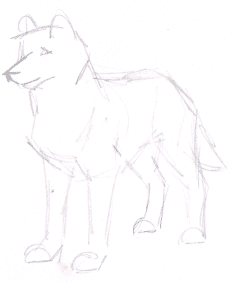


Step 1
When I
draw canines, like the wolf above, I usually start by drawing the basic shape.
If you look closely, you can see that the wolf is basically a bunch of circles,
squares etc,
like shown on the little pic. I hint just barely how to place the shoulders,
head etc, and put a slight expression on the face to help me with the posture.
This wolf looks rather peaceful. Since this is just the basic sketch, draw
lightly! Try to keep the sketch as clean as possible.
If you want to go more "advanced" than circles that are often used by
beginners (and pros), try using the simplified skeleton! You can learn more
about this method under the tutorial "A note on drawing canines"! It
might be easier to get a good 3D-look using the skeleton, but you will also need
some basic knowledge about canine anatomy to be able to use it right.
![]()
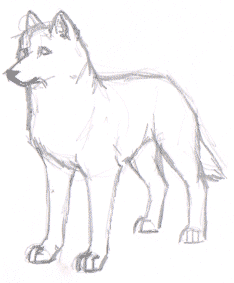
Step 2
More
details... I've added the fur here. Wolves have especially long fur on their
cheeks, their necks and tails. They don't have that much fur on their legs
though.
I decided to make this wolf a female, which means that I gave
her slightly more slender legs, thinner muzzle and more slender body than I
would have if she was a he.
Even though our wolf is beginning to look like
something, there are still things to improve. And this is the step where you
decide that! Look your pic over, and fix the biggest
mistakes (if you did any *grin*)
![]()
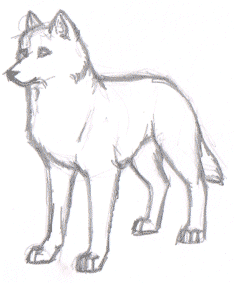

Step 3
More details
:)
To the right, you'll find an old image where I've drawn some of the major muscles on a canine
body, in case you wanna draw an athethic looking wolfie! To become better at
drawing animals, I strongly recommend learning at least some anatomy! It is a
*very* basic pic, and anybody who knows about anatomy would probably laugh at it
(I do! He he), but it might help you at least somewhat. The head is too large,
stomach too small etc, but muscles are placed at the right spots :) Pink represents large muscles ("outer" muscles, the ones you can see on a muscular doggy) and blue represent
visible veins. You usually can't see the ones except for those on the legs,
though, at least not if your doggie is long-haired.
There are, of course, more muscles and stuff, but I didn't draw them
here. You could always go to the library and look for a book about dog anatomy.
It's really helped me!
![]()
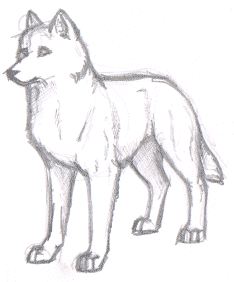
Step 4
If drawing
a long-haired dog, you can always hint muscles by drawing fur, like I did above.
I've also added a few shadows. Now we just need a few markings... Unless you
want a white or black wolf, of course :)
![]()
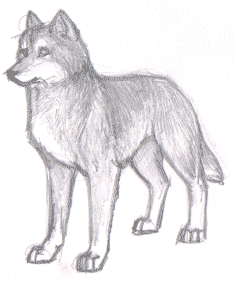
Step 5
Finally :)
I've done a very basic colouring job here. It shows how many wolves are marked,
although the variations are many - there are lots of different colours among
wolves. They often have white around their eyes, white muzzle and white cheeks.
Their underside is usually a lighter colour than their back (very common
camouflage for many different animals, from wolves to fish!)
When I did this colouring, I started by giving the wolf a smooth, even layer of
grey. I then worked on this, adding darker here and there to get the finished
result.
When you are
happy with your colouring, you finally have a wolf, like my wolf-girl
here! I hope you like how yours turned out!
![]()